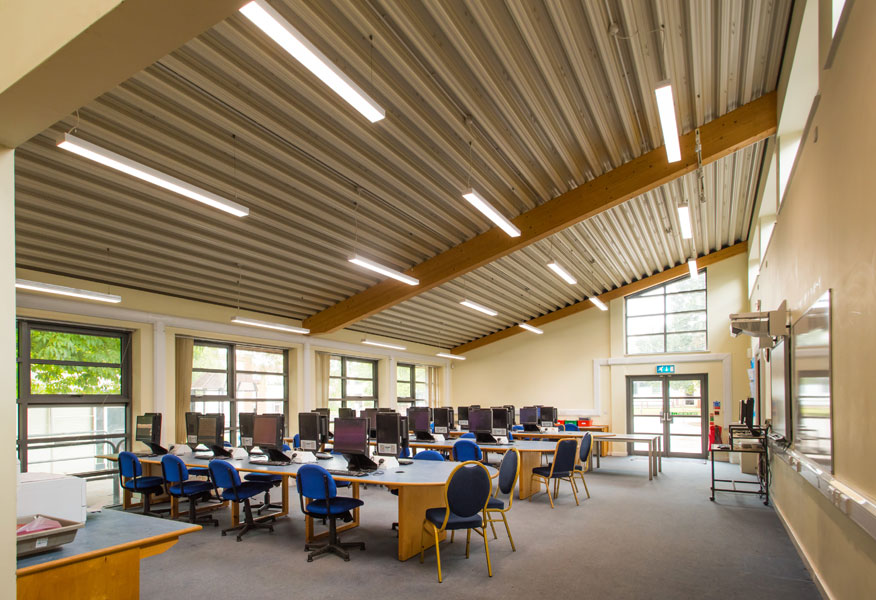
Lighting for Wellbeing in Universities, Colleges and Schools
Awareness of the positive contribution that lighting can make to students’ ability to concentrate and learn is growing all the time, says Tamlite Lighting’s Head of Wellbeing Debbie-Sue Farrell.
During a period when awareness of environmental factors and concern about the number of days lost to ill-health are becoming increasingly acute, it’s hardly surprising that the issue of wellness in the workplace is now significantly higher than it was a decade ago. But the issue certainly isn’t limited to the world of work. Researchers continue to highlight the positive contribution that better lighting can make to schools, colleges and universities.
In particular, there is now a wealth of study to reinforce the assertion that students fare better with the higher illuminance levels that are commonly found in the latest LED lighting systems. A study referenced on the Lighting for People website(1) found that children in the experimental group – which optimised lighting with a 1,000 lux illuminance level and 6,500K (cold white) colour temperature – ultimately scored significantly higher in terms of their oral reading fluency compared to a control group. The study also indicated “a positive upwards trend for motivation under the optimised lighting, while the trend for motivation under standard lighting declined during the school year.”

The marked difference that good lighting can make on student productivity and effectiveness is further underlined by recent data collated by the EU-backed Lighting Europe initiative. Their research (2) notes that students can achieve up to 14% higher scores in healthy buildings equipped with optimised lighting systems. Lighting systems that complement human rhythms are crucial given that light has a demonstrable effect on three central areas, determined by Lighting Europe to be: Vision – sight, safety and orientation; Body – alertness, cognitive performance and sleep/wake cycle; and Emotion – mood, energies and relaxation. It is of course important to remember the benefit that this can have on reducing teacher/lecturer stress levels too; calmer, more engaged students will be easier to teach, after all.
Fortunately, with the latest LED lighting and control technologies, it is now easier than ever before to identify and install systems that will work to the benefit of both students and teachers.
Perfect balance
For building engineers and consultants wishing to encourage schools, colleges and universities to investigate improved lighting for wellbeing, the good news is that many educational establishments are increasingly looking to implement any measure that may help them in a highly competitive and rigorously tested marketplace. Focus on the following three ‘lessons’ and the case for upgrading may soon pass from good to compellingly persuasive…
1) Everyone accepts that temperature, humidity and ventilation are vital considerations, and the same should apply to lighting. By seeking a perfect balance between natural and artificial light, with different light output at different times of day, it is possible to offer illumination that works in conjunction with students’ natural rhythms.
2) Deploying dynamic and tunable lighting systems – whereby light intensity and tuning spectrum can be adjusted in accordance with different requirements throughout the course of the day – constitutes the most effective route to achieving what is increasingly being labelled as ‘biologically effective’ lighting.
3) The transition to LED-based lighting has been ongoing in education for many years, but it’s always worth briefly restating some of the other primary benefits. Not only does it offer a more consistent and appealing quality of light, it also uses significantly less energy and can result in RoI periods of just a year or two – even in sizeable, school-wide installations.

Engineers working with schools and colleges also need to think carefully about choosing user-friendly controllers and interfaces, allowing staff to make easy ‘on the fly’ adjustments in response to concerns or requests.
With a number of funding schemes – most notably Salix Finance - available to assist educational establishments to upgrade to the next-generation lighting, it would be an oversight not to mention that engaging the services of a specialist lighting company is invariably going to be an astute move. Not only will they be able to make sure the system is optimised at the time of installation, they will also be able to provide support and fine-tuning expertise as the years go by, guaranteeing that the lighting will continue to work in the favour of students and teachers.
Featured in the CIBSE Journal and Bimingham Business Post